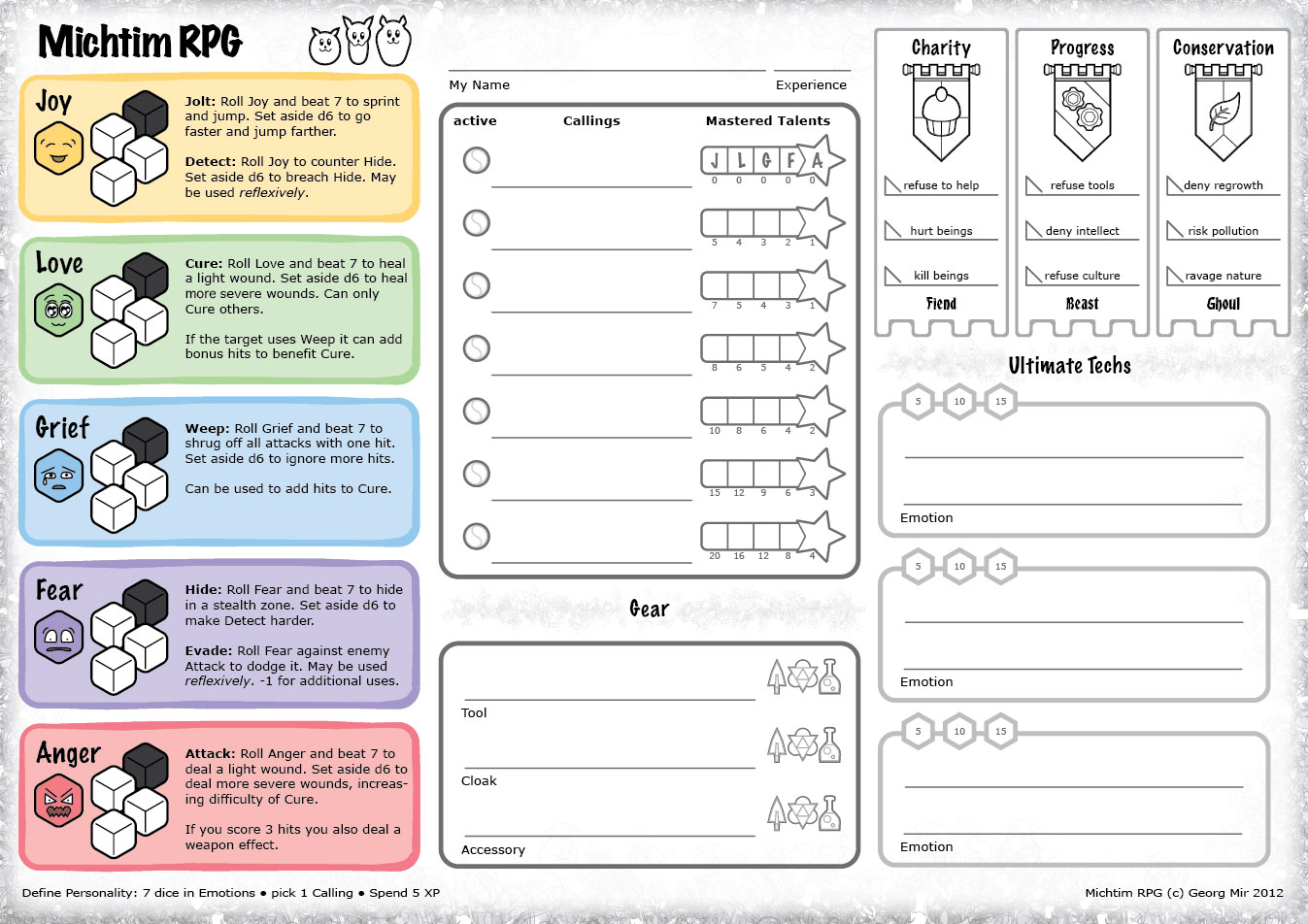So here we are again, another update to the character sheet. This time I was taking a look at different roleplaying games, and how they were handling ethics. You can read my short analysis of D&D 3.5 Alignments and Vampire the Masquerade’s Humanity/Path system.
Dungeons & Dragons 3.5: Alignments
A creature’s general moral and personal attitudes are represented by its alignment [..] Alignment is a tool for developing your character’s identity. It is not a straitjacket for restricting your character. Each alignment represents a broad range of personality types or personal philosophies, so two lawful good characters can still be quite different from each other. In addition, few people are completely consistent. A lawful good character may have a greedy streak that occasionally tempts him to take something or hoard something he has, even if that’s not lawful or good behavior. People are also not consistent from day to day. A good character can lose his temper, a neutral character can be inspired to perform a noble act, and so on. (Dungeons & Dragons 3.5, 103)
Dungeons & Dragons 3.5 features two axes of ethical distinctions. One axis concerns itself with questions of good and evil. The other axis evaluates lawful and chaotic behavior. Through a combination of the two, an alignment type is formed.
Good characters and creatures protect innocent life. Evil characters and creatures debase or destroy innocent life. [..] “Good” implies altruism, respect for life, and a concern for the dignity of sentient beings. Good characters make personal sacrifices to help others. “Evil” implies hurting, oppressing, and killing others. Some evil creatures simply have no compassion for others and kill without qualms if doing so is convenient. (Dungeons & Dragons 3.5, 104)
While this description provides some general pointers to what a Good character is supposed to do, there are no mechanics to deal with transgressions. Dungeon-Masters will usually ask players to change their alignment, if they feel that a different combination is more appropriate for the character. This may trigger negative consequences: a cleric of a Good deity may not be of an Evil alignment, so the sinful behavior will lead to the cleric’s fall from grace. Still, the decision is up to the Dungeon-Master, and no framework is provided to cope with unfitting behavior in Dungeons & Dragons.
Analysis: While there is a basic idea of how heroes are supposed to act, the game provides no mechanics and structures to change the character’s alignment. On the other hand, the game assumes a universally true status of the character’s alignment. There are spells and items that are affected by the character’s alignment. A heavenly tome might paralyze any Evil character daring to touch it, for example. This assumes that even if a character has good intentions, the Alignment is a fixed Attribute that does not depend on the point of view. Instead it is assumed to be a factual entity that is clearly defined. This creates a simplistic philosophy that has a tendency towards fundamentalism. Clearly the bad guys deserve punishment by the morally unquestionable heroes.
Vampire the Masquerade: Humanity / Paths
Vampire the Masquerade uses a “Hierarchy of Sins” to track transgression against morality. The game features different philosophies, but the primary outlook is called “Humanity”. This attribute can be rated on a scale ranging from 10 (saintly) to 0 (inhuman monster).
If a vampire kills a victim, the player looks up the character’s Humanity rating and the Hierarchy of Sins. If the Humanity rating is low enough, nothing happens at this point. If the character still is somewhat human in her outlook, the player needs to roll a special attribute called Conscience, to see if the vampire regrets her deed.
Instead of just providing a simple label like Good or Evil, the game allows players to pick their own set of ethics. The Hierarchy of Sins provides a detailed guideline of forbidden or demanded actions. As long as they can stick to these guidelines, the character will not suffer consequences. This outlook is not a universal attribute, although it certainly affects the way the character interacts with her environment. The Humanity (or Path) rating will influence the reactions of humans and time spent in deathly torpor (until resurrection is possible).
Analysis: There are rules for gaining and losing Humanity. There are multiple Paths that serve as alternatives for Humanity. The rating has severe effects on the gameplay, and is valuable. If the rating is low enough, the character might be taken away from the player. The Hierarchy of Sins provides a basic guideline to the players, so that they do know what is expected of them.
Virtues and Sins in Michtim RPG
There are three houses (formerly tribes) in Michtim culture. Each favoring one kind of ideology. While I try to be concise with the naming of virtues, they are better defined by their relevant transgressions. Charity vs Callousness, Progress vs Regression and Conservation vs Ravaging.
Characters gain Karma for good deeds (playing to the three virtues), while gaining corruption markers when sinning. Sins have story-consequences (like loss of reputation), as well as mechanical impairments. Karma can only be gained when sins have been atoned for. While a certain level of corruption is sustained, it will not increase — except when the Michtim commits an even more sinister deed.

